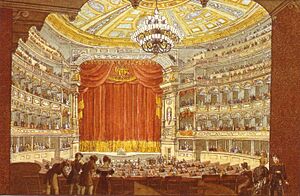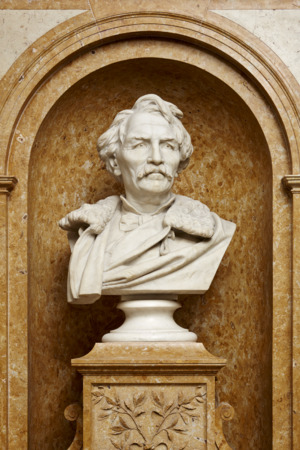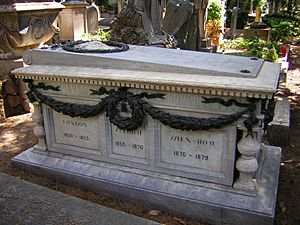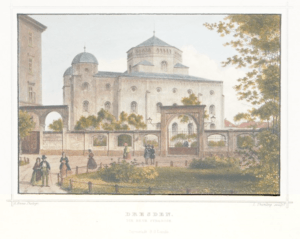Gottfried Semper facts for kids
Quick facts for kids
Gottfried Semper
|
|
|---|---|

Gottfried Semper
|
|
| Born | 29 November 1803 Altona, Duchy of Holstein
|
| Died | 15 May 1879 (aged 75) |
| Occupation | Architect |
| Buildings | Semper Opera House |
Gottfried Semper (born November 29, 1803 – died May 15, 1879) was a famous German architect. He was also an art critic and a professor of architecture. He is best known for designing the beautiful Semper Opera House in Dresden, Germany, which he built between 1838 and 1841.
In 1849, Semper was part of the May Uprising in Dresden, a time when people wanted more democratic changes. Because of this, the government wanted to arrest him. Semper had to leave Germany, first going to Zürich and then to London. He was able to return to Germany later, in 1862, after a special pardon was given to those involved in the uprising.
Semper wrote many books about how architecture began. One of his most important books was The Four Elements of Architecture from 1851. He was also a key person in a big discussion about whether buildings in ancient Greece were painted in bright colors, a style called polychromy. Semper designed all sorts of things, from large city plans, like the re-design of the Vienna Ring Road in Vienna, to small items, like a special stick for the composer Richard Wagner. Wagner even used Semper's ideas for an opera house in Munich to build his own Bayreuth Festspielhaus, without Semper's permission!
Contents
Semper's Early Life and Studies
Gottfried Semper was born into a wealthy family in Altona, Hamburg. He was the fifth of eight children. In 1823, he started studying history and math at the University of Göttingen. Later, in 1825, he studied architecture at the University of Munich.
In 1826, Semper moved to Paris to work with an architect named Franz Christian Gau. He was even there during the July Revolution of 1830, a time of big political change. From 1830 to 1833, he traveled to Italy and Greece. He wanted to study the old buildings and designs from ancient times. In 1832, he spent four months helping with archaeological digs at the Acropolis in Athens.
During his travels, Semper became very interested in a debate about colors. People were wondering if buildings in Ancient Greece and Rome were painted in bright colors. Semper drew pictures of how ancient villas might have looked with paint. These drawings later inspired his own designs for painted decorations in Dresden and Vienna. In 1834, he published a book called Preliminary Remarks on Polychrome Architecture and Sculpture in Antiquity. In this book, he strongly argued that ancient buildings were indeed colorful. This idea, supported by his studies of paint on Trajan's Column in Rome, made him famous in architecture circles across Europe.
Working in Dresden (1834–1849)
On September 30, 1834, Semper became a Professor of Architecture in Dresden. This happened thanks to his former teacher, Franz Christian Gau. Dresden was growing fast, which gave Semper many chances to design new buildings.
From 1838 to 1840, a synagogue was built in Dresden based on Semper's design. It was called the Semper Synagogue. Its inside was designed in a Moorish Revival style, which was very decorative. The outside looked more like a Romanesque church, so it would blend in. The inside also had special furnishings, like a silver lamp that caught the eye of composer Richard Wagner. Semper's student, Otto Simonson, later built the grand Moorish Revival Leipzig synagogue in 1855.
Some of Semper's buildings in Dresden are still standing today. These include the Semper Gallery of the Zwinger Palace complex. His first building for the Dresden Hoftheater (court theater) burned down. But the second one, now known as the Semperoper, was built in 1841 and is still famous. Other buildings linked to his name include the Maternity Hospital, the Oppenheim Palace, and the Villa Rosa. The Villa Rosa was built for a banker and became a model for German villa architecture.
On September 1, 1835, Semper married Bertha Thimmig. They had six children together.
Semper strongly believed in a republic, where people have more say in government. He joined his friend Richard Wagner in the May Uprising in Dresden in 1849. He was part of the Civic Guard and helped build barricades in the streets. When the uprising failed, Semper was seen as a leader who wanted democratic change. He was forced to leave Dresden.
He never returned to Dresden, even though it became the city most famous for his buildings. The government wanted to arrest him until 1863. When the Hoftheater, designed by Semper, burned down in 1869, the King of Saxony, King John, asked Semper to design a new one. Semper drew the plans, but his son, Manfred, oversaw the actual building.
Semper once wrote, "What must I have done in '48, that one persecutes me forever? One single barricade did I construct - it held, because it was practical, and as it was practical, it was beautiful."
Life After the Revolution (1849–1855)
After leaving Dresden, Semper stayed in several cities like Zwickau and Strasbourg. He eventually went back to Paris, like many others who were disappointed by the failed revolutions of 1848. In the fall of 1850, he moved to London, England.
In London, he found some work, like helping design the funeral carriage for the Duke of Wellington. He also designed parts of the Canadian, Danish, Swedish, and Ottoman sections for the 1851 Great Exhibition in the Crystal Palace. Even though he didn't find a steady job, his time in London was very important for his ideas and writings. He published Die vier Elemente der Baukunst (The Four Elements of Architecture) in 1851. He also published Wissenschaft, Industrie und Kunst (Science, Industry and Art) in 1852. These books laid the groundwork for his most famous work, Der Stil in den technischen und tektonischen Künsten oder Praktische Ästhetik, which came out in two parts in 1861 and 1863.
Working in Zürich (1855–1871)
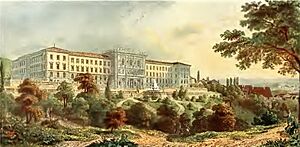
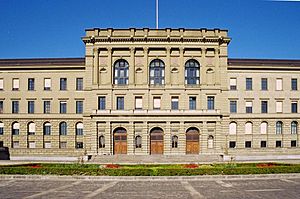

Around the time of the Industrial Revolution, Switzerland decided to build a new technical school. Semper was a main judge for the design competition. He didn't like any of the designs, so he ended up designing the building himself! The new school was built on a terrace overlooking Zürich, where old fortified walls once stood. It was visible from everywhere and became a symbol of a new era. The building (built from 1853–1864) still shows Semper's original ideas, even after many changes. It was first meant to house both the new school (now called the ETH Zurich) and the existing University of Zurich.
In 1855, Semper became a professor of architecture at this new school. Many of his students became very successful architects, which helped secure his legacy. With his professor's salary, Semper was able to bring his family from Saxony to Zurich. The City Hall in Winterthur is another building in Switzerland designed by Semper.
Semper also created a design for Bavaria's King Ludwig II. This was for a theater in Munich dedicated to the music of Richard Wagner. The project, worked on from 1864 to 1866, was never built. However, Wagner used many of Semper's ideas for his own theater in Bayreuth.
Later Life (from 1871)
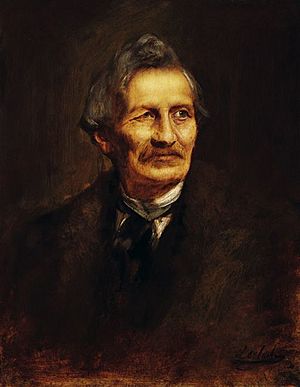
As early as 1833, there were plans in Vienna to show the Imperial Art Collections to the public. When the Vienna Ring Road was being planned, the need for new museums became urgent. The emperor's art collection was spread out in many different buildings. Semper was asked to suggest where to put new buildings along the Ring Road. In 1869, he designed a huge 'Imperial Forum,' but it was never built. However, the National Museum of Art History and the National Museum of Natural History were built opposite the Palace, following his plan. The Burgtheater was also built. In 1871, Semper moved to Vienna to work on these projects.
During the construction, Semper had many disagreements with the architect he was working with, Karl Freiherr von Hasenauer. Because of this, Semper left the project in 1876. The next year, his health started to get worse. He died two years later while visiting Italy and is buried in the Protestant Cemetery, Rome.
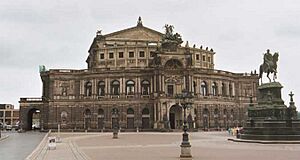
Semper's Legacy
- Semperdepot, Lehargasse, Vienna
Selected Works
- Dresden
- Hoftheater – 1838-1841 (destroyed by fire in 1869)
- Villa Rosa – 1839 (destroyed in the Second World War)
- Semper Synagogue – 1839-1840 (destroyed on November 9, 1938, during Kristallnacht)
- Oppenheim-Palace – 1845-1848
- Semper Gallery (Dresden Gemäldegalerie)– 1847-1855
- Neues Hoftheater (Semperoper) – 1871-1878
- Zürich
- City Hall – 1858 (only a concept for a competition; not built)
- Polytechnical School, (ETH Zurich) – 1858-1864
- Observatory - 1861-1864
- Winterthur
- City Hall – 1865-1869
- Vienna
- Municipal Theater (Burgtheater) – 1873 - 1888
- Museum of Art History (Kunsthistorisches Museum) (1872–1881, finished 1889)
- Natural History Museum (Naturhistorisches Museum) (1872–1881, finished 1891)
Images for kids
-
Polytechnikum in 1865
-
ETH Zurich Hauptgebäude (main building)
-
Stadthaus (city hall) Winterthur
-
Franz von Lenbach's portrait of Gottfried Semper shortly before his death
-
Semper's (second) Dresden Opera House as it is today
See also
In Spanish: Gottfried Semper para niños



